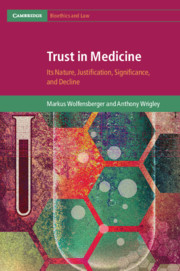Book contents
- Trust in Medicine
- Cambridge Bioethics and Law
- Trust in Medicine
- Copyright page
- Dedication
- Contents
- Figures
- Tables
- Preface
- Acknowledgements
- A Note on Usage
- Part I Introduction
- 1 Introduction
- 2 Empirical Evidence for the Decline of Trust
- Part II The Nature of Trust
- Part III Justification of Trust
- Part IV Significance of Trust
- Part V The Decline of Trust
- Part VI Perspectives
- References
- Index
- Series page
1 - Introduction
from Part I - Introduction
Published online by Cambridge University Press: 19 August 2019
- Trust in Medicine
- Cambridge Bioethics and Law
- Trust in Medicine
- Copyright page
- Dedication
- Contents
- Figures
- Tables
- Preface
- Acknowledgements
- A Note on Usage
- Part I Introduction
- 1 Introduction
- 2 Empirical Evidence for the Decline of Trust
- Part II The Nature of Trust
- Part III Justification of Trust
- Part IV Significance of Trust
- Part V The Decline of Trust
- Part VI Perspectives
- References
- Index
- Series page
Summary
“The everyday usage of ‘trust’ is very broad. A brief analysis of a few typical statements shows that in many instances it would be more appropriate to talk of confidence, reliability, belief in something or someone, or even hope. Not only in folk usage, but even in the scholarly literature, the term ‘trust’ is often used very vaguely. To remedy this, the authors present a definition of trust that is able to both underpin an account of the decline of trust and support an explanation as to why we should worry about the decline of trust.Two clinical model case histories are presented which help illustrate (1) that trust has declined over the past forty years or so; (2) that patients perceive both competence and a patient-oriented commitment of the physician as relevant features of physicians trustworthiness; (3) that uncertainty and risk are important features of ‘trust’; and, finally, (4) that the way patients’ justify taking the risk of trusting has changed over the past decades.
- Type
- Chapter
- Information
- Trust in MedicineIts Nature, Justification, Significance, and Decline, pp. 3 - 10Publisher: Cambridge University PressPrint publication year: 2019



